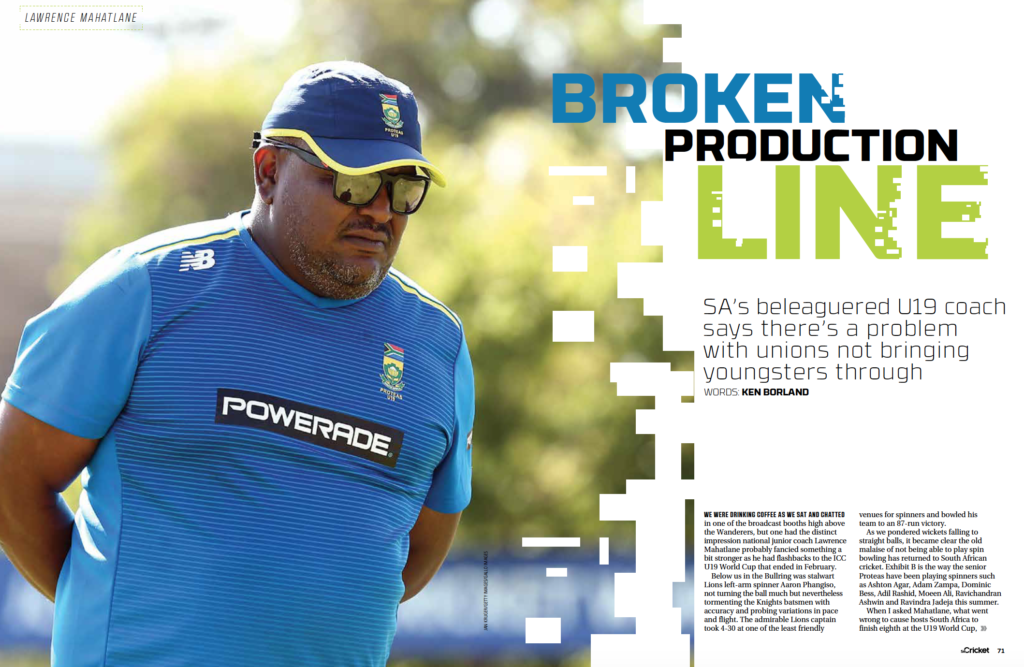In light of the poor record by South Africa’s Under-19s, coach Lawrence Mahatlane says there’s a problem with unions not bringing youngsters through, writes KEN BORLAND.
We were drinking coffee as we sat and chatted in one of the broadcast booths high above the Wanderers, but one had the distinct impression national junior coach Lawrence Mahatlane probably fancied something a bit stronger as he had flashbacks to the ICC U19 World Cup that ended in February.
Below us in the Bullring was stalwart Lions left-arm spinner Aaron Phangiso, not turning the ball much but nevertheless tormenting the Knights batsmen with accuracy and probing variations in pace and flight. The admirable Lions captain took 4-30 at one of the least friendly venues for spinners and bowled his team to an 87-run victory.
As we pondered wickets falling to straight balls, it became clear the old malaise of not being able to play spin bowling has returned to South African cricket. Exhibit B is the way the senior Proteas have been playing spinners such as Ashton Agar, Adam Zampa, Dominic Bess, Adil Rashid, Moeen Ali, Ravichandran Ashwin and Ravindra Jadeja this summer.
When I asked Mahatlane, what went wrong to cause hosts South Africa to finish eighth at the U19 World Cup, he said: ‘Our batting group did not put enough runs on the board due to the way they played spin in crucial moments.’
The pure numbers show this clearly. In the games South Africa lost, they were blown away like powder for scores of just 129, 157, 143 and 154 by the spin-based attacks of Afghanistan (twice), Bangladesh and West Indies.
Mahatlane believes it is not a lack of talent but rather a lack of exposure that causes the necessary skills to remain undeveloped. Quality spin bowlers are thin on the ground in South African schools cricket so leading batsmen are not used to being put under pressure by slow bowlers.
‘The recent history of the ICC U19 World Cup shows how the subcontinent teams have dominated, we did our best to expose ourselves to quality spin by playing a series against India and Afghanistan in India. But the big difference is that at schools level there is usually at least one loose ball in an over; so our batsmen know they can afford to block four deliveries because the boundary ball is coming.
‘If you look at our modes of dismissal in the World Cup, most of the guys were bowled or out lbw which shows they are trying to make something out of quality bowling, trying to hit through midwicket or the covers when they should be playing straight down the ground. As coaches, we tried to make sure we had covered all the bases but it was execution that let us down,’ Mahatlane said.
As soon as a decent spinner came on and bowled wicket-to-wicket, the SA U19 batsmen simply dissolved under the pressure.
‘Luke Beaufort played spin the best, and Bryce Parsons and Jonathan Bird had their moments but for the rest there were a whole lot of strange dismissals. And that’s despite playing a lot of cricket – we were in the top five in terms of the number of games we played before the World Cup and we even took on senior provincial teams. We also had only two guys in the squad this year who were already out of school.
‘There’s an amazing growth in boy’s cricket between the ages of 18 and 20 and I would like to see them get exposed more to senior cricket. At schoolboy nets the spinner is normally always running back to fetch the ball but being exposed at provincial level – they don’t necessarily have to play, even just being at nets would help – will teach them how to play under pressure,’ Mahatlane continued.
In other countries, the top junior cricketers are brought into the senior teams far quicker so they are not just dominating their less-talented peers. SA’s U19 World Cup squad boasted 20 List A and 20 first-class games between them; eventual champions Bangladesh had a team with 123 senior List A appearances. Even Afghanistan’s boys were sharpened by far more exposure to men’s cricket, with 49 appearances in 50-over and 109 in first-class cricket. Opener Ibrahim Zadran had already played two Tests, an ODI and three T20s for Afghanistan. His 87 in the second innings of the Test against Bangladesh in September helped Afghanistan to a famous win.
‘There’s a massive difference in how other countries approach their U19 team, compared to schools cricket. Pakistan’s Naseem Shah (above) is a prime example, playing Test cricket when he was still 16. We only had one guy who had franchise experience, only four Bangladeshis hadn’t played at that level. At provincial level there are far too many boys for us to look at them all properly. Even the guys chosen for the squad, we see them for only two weeks at a time.
‘But internationally the trend is to have more provincial teams, which gives more opportunities for exposure. This is why I would like to see our best U19 cricketers playing in the Senior Provincial One-Day Competition on Sundays, especially for the home team, as this would expose the youngsters to pressure cricket. At the moment they are not exposed to consistent pressure.’
Mahatlane, who has been involved in the national U19 set-up since 2002 when South Africa – with Hylton Ackerman as head coach – lost to Australia in the final, believes the gems are in the pipeline, it is just how they are polished that is the problem.
‘I thought the group we had this year was good enough to do well and I believe a couple of them will still be spoken about in 10 years’ time. Our system is very good, although we need to spend a lot more quality time with our batsmen. We have amazing talent but we need to back these talented youngsters so senior cricket can provide another filter. The system works but I would like to see them take an earlier step into provincial cricket.
‘The cancellation of the U19 three-day competition has left me wondering whether our guys can bat for long periods under pressure. Previously we had guys like Hashim Amla, Imraan Khan and Graeme Smith making double hundreds in three-day cricket and I’d like to see us go back to that. India, for example, can be 20-3 but there’ll still be someone in the top seven who will make a hundred,’ Mahatlane says.
It is important to bear in mind, though, that the U19 World Cup has generally not been a happy hunting ground for South Africa. Perhaps the triumph in 2014 under Ray Jennings and Aiden Markram has created too much expectation. The only other times South Africa have played in the final were 2002 and 2008.
Mahatlane caused some consternation in the U19 change room when he first addressed the latest intake of hopefuls and told them that only a couple of them would go on to play in international cricket for a lengthy period of time.
‘It was a reality check but I had to tell them the odds are only that two of them will be playing for the Proteas for 10 years. Only a couple of players per team become really good international cricketers so producing players for our local system is actually our goal. They are just starting their careers and are being thrown into these big games. Maybe the expectations are too much. We shouldn’t be surprised when they make schoolboy errors.
‘And the way the game has evolved with the advent of social media, there’s a lot more attention on the players. Previously South Africa lost twice to Nepal, including when Ray Jennings was coach, but not much was said. But the extra attention is not a bad thing, it’s important how they handle it,’ Mahatlane says.
Getting former Proteas involved will not necessarily solve South Africa’s U19 problems either – Robin Peterson was on the coaching staff until he was appointed Warriors coach and even he became frustrated because the kids resort to old habits under pressure.
Perhaps, as Mahatlane himself pleads, the answer lies in the individual unions involving their own talent more in their senior systems.
MAHATLANE’S ODI RECORD
2014
vs England (a) Lost 5-0
2015
vs Bangladesh (a) Lost 6-1
vs Bangladesh (h) Lost 5-2
2015-16
World Cup (in Bangladesh, finished 11th)
Lost to Bangladesh, Namibia, Zimbabwe
Beat Scotland, Ireland, New Zealand
2016
vs Sri Lanka (a) Lost 2-1
2016-17
Tri-Nations Tournament (h)
Beat Zimbabwe (twice), Sri Lanka (three times)
Lost to Zimbabwe, Sri Lanka (final)
vs Sri Lanka (h) Won 2-1
2017
vs West Indies (h) Lost 3-2
2017-18
Tri-Nations Tournament (h)
Beat Namibia (twice), England (final)
Lost to England (twice)
World Cup (in New Zealand, finished fifth)
Beat Kenya, West Indies, New Zealand (playoff semifinals), Bangladesh (fifth-place playoff)
Lost to New Zealand, Pakistan (playoff quarterfinals)
2018
vs England (a) Won 2-0
2018-19
Quadrangular Series (in India)
Lost to India ‘A’, India ‘B’
Beat Afghanistan (twice)
2019
vs Pakistan (h) Lost 7-0
2019-20
vs India (h) Lost 2-1
Quadrangular Series (h)
Lost to India (twice), Zimbabwe Beat New Zealand
World Cup (in SA, finished 8th)
Lost to Afghanistan, Bangladesh, West Indies, Afghanistan (seventh-place playoff)
Beat Canada, United Arab Emirates
Overall record: Played 80 Won 31 Lost 49
– This feature first appeared in the April-June issue of SA Cricket Magazine







